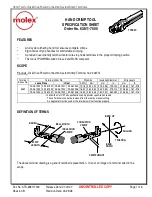
MUC122SP 6 07/14/15
MUC122SP 12V Surface Prep Tool
MATCO CORDLESS BATTERY USE AND CARE GUIDE
IMPORTANT!
All rechargeable batteries have a finite lifespan and will slowly
lose storage capacity as they age and are cycled . Rechargeable
batteries are consumable items and should be carefully treated
to ensure proper operation during its limited lifespan . Please read
the following guide carefully for tips that may maximize the
performance of your Matco rechargeable batteries . Batteries
should be handled with care and disposed through proper
authorities .
WARNING! MUST READ!
Do not crush or incinerate batteries as it may cause danger
from explosion. Do not place batteries in confined spaces
where it may be in contact with conductive objects. For
example, do not place battery in pockets, tool boxes, tool
bags, etc. with screws, keys, metal shavings, etc. as the
battery may short circuit and/or cause fire hazard.
Only charge in Matco chargers and never attempt to wire to
alternative charging sources Danger of explosion, electric shock,
fire, and electrocution may result from:
- Abuse, misuse, and severe shock
- Subjecting the unit to conductive particles, objects,
and liquids
- Connecting two chargers together
- Charging Matco batteries with other chargers
- Using the Matco charger to charge other batteries
- Operating the charger with a damaged cord or plug
PROPER CARE WILL MAXIMIZE PRODUCT LIFE
Please note that there are differences in the care of
Lithium-Ion and Nickel-Cadmium batteries.
PROPER CARE FOR MATCO INFINIUM
LITHIUM-ION (LI-ION) BATTERIES
- All Li-ion batteries are sensitive to high temperature and
should be kept cool, dry, and out of direct light exposure . Ideal
temperature range for operation and storage is between 32
and 75 °F . Li-ion batteries may be stored in the refrigerator,
but freezers are not recommended .
- Do not leave batteries unused for extended periods of time,
especially when it is fully charged or fully discharged . Bring
a Li-ion battery to approximately 50% charge level before
storing .
- Li-ion batteries are sensitive to shock . Avoid dropping, hitting,
or exposure to vibration .
- Li-ion can be charged frequently and recharged before it
is fully depleted . Li-ion, in fact, is ideally recharged before it
is completely depleted . Recharging when there is 25%-50%
capacity remaining in the battery may prolong its lifespan .
- Contaminants can adversely affect the performance and life
of Li-ion batteries . Minimize the battery’s exposure to dust,
dirt, and small particles .
- Recharge Matco Li-ion batteries only in Matco recharging
devices that are designed specifically for the battery type .
Never subject batteries to any other quick-charging, quick-
discharging, or quick-restoring devices .
PROPER CARE FOR MATCO NICKEL-CADMIUM
(NI-CD) BATTERIES
- Ni-Cd batteries are sensitive to high temperatures and should
be kept cool, dry, and out of direct light exposure . Ideal
operating and storage temperature is between 32 and 70 °F .
Ni-Cd batteries may be stored in a refrigerator, but freezers
are not recommended .
- Do not leave batteries unused for extended periods of time .
Store Ni-Cd batteries fully discharged in a cool and dry place .
- Ni-Cd batteries are sensitive to shock . Avoid dropping, hitting,
or exposure to vibration .
- Ni-Cd batteries should be fully discharged inside the tool
before recharging . Furthermore, the battery should be fully
charged before it is removed from the charger . Frequent
charges and removals at intermitting levels may reduce
the capacity of the battery .
- Perform the “Refresh Cycle” for Ni-Cd batteries inside the
Matco MUCHRG1 Universal Charger on a monthly basis . For
light usage, perform this function once every three months .
Note that this feature is not applicable or necessary for
Li-ion batteries .
- Contaminants can adversely affect the performance and life
of Ni-Cd batteries . Minimize the battery’s exposure to dust,
dirt, and small particles .
- Recharge Matco Ni-Cd batteries only in Matco recharging
devices that are designed specifically for the battery type .
Never subject batteries to other quick-charging, quick-
discharging, or quick-restoring devices .






































